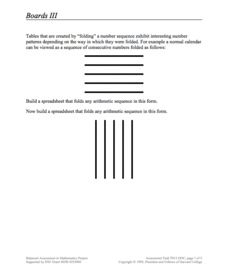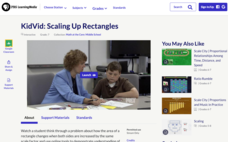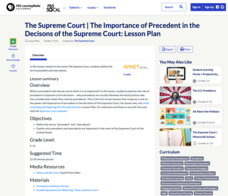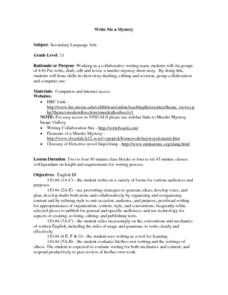PBS
Analyzing Light Curves of Transiting Exoplanets
Scientists detected exoplanets by measuring how the brightness of stars changed over time. Young astronomers interpret and analyze the same data that led to exoplanet discoveries. They learn to apply light curve graphs and connect the...
Concord Consortium
Boards III
Learn to visualize mathematical patterns as a folded pattern. Beginning with a visual display, the task encourages pupils to view sequences as a folded table. The pattern of the table then becomes a formula in a spreadsheet that...
Biology Junction
ADP, ATP, and Cellular Respiration
Hans Krebs won the Nobel Prize for his discovery of what scientists now know as the Krebs cycle. Named after him, the Krebs cycle exists as only one system of the larger set, working together to keep human bodies functioning. The...
PBS
KidVid: Scaling Up Rectangles
Tip the scale in your favor when learning about scale factors. After viewing a video clip of a learner trying to determine the scale factor of the areas of two rectangles, scholars consider how changing the dimensions of a rectangle...
Middle Tennessee State University
The Declaration of Independence: Its Legacy and Ideas in Today’s World
How is it possible that such an old document still triggers modern discussions? Teach scholars why the Declaration of Independence is still so important today using an informative resource. They watch various educational videos, work in...
PBS
The Supreme Court: The Importance of Precedent in the Decisions of the Supreme Court
People often hear the words precedent and Supreme Court together, but why? A resource on the Supreme Court includes a variety of discussion questions, handouts that guide young historians, a video about Nixon and the court system, and...
DiscoverE
Foil Boats
How many pennies can an aluminum foil boat hold? That is the challenge in a collaborative activity designed to explore the concept of buoyancy. Learners use aluminum foil to build makeshift boats and test the weight they hold before...
Science Matters
Under Pressure
Sometimes a little pressure isn't a bad thing! A collaborative instructional activity uses models to demonstrate how air pressure inflates and deflates the lungs. Participants use everyday materials to create models of the chest cavity...
EngageNY
Grade 11 ELA Module 2: Unit 1, Lesson 16
Take a second look. Scholars examine the chapter "Of Our Spiritual Strivings" as a whole and once again work in groups to discuss Du Bois's use of figurative language. They also complete the Mid-Unit Assessment Evidence Collection Tool...
EngageNY
Launching the Novel: Character Analysis of Ha
Scholars receive numbers as they work in groups to read Inside Out & Back Again. The instructor calls out specific numbers for readers to share the group's thoughts. Then, they use a model passage to demonstrate the effective actions...
EngageNY
Pairing Texts: Understanding Brown v. Board of Education’s Impact on Carlotta’s Journey
Scholars work in groups to compare Brown v. Board of Education excerpts and A Mighty Long Way. They use the Paired Text note catcher to organize their thoughts and divide the work using a jigsaw activity to track Carlotta's journey.
DocsTeach
The Treaty of Guadalupe Hidalgo
The Treaty of Guadalupe Hidalgo ended the Mexican-American War, but it did not end tensions between the two nations. The activity provides learners with an opportunity to practical historical analysis with text experts from the Treaty of...
Texas Education Agency (TEA)
Investigating Careers - Sign Me Up!
Extra, extra, learn all about it! Students view posters, brochures, and other resources to discover the extracurricular activities offered in the school and community. They also write a self-reflection sharing their knowledge about the...
University of Florida
A Walk in the Woods
Take class members on a field trip to the forest without leaving the classroom. Scholars learn content-related vocabulary and factors affecting forest health with class discussions and during a presentation. Scientists combine forestry...
Center for History Education
Who Fired the Shot Heard Round the World?
Take a closer look. Young academics become detectives in an engaging lesson on the American Revolution. Scholars work in groups to analyze documents to uncover whether the American colonists or British soldiers fired the first shot at...
British Council
The Months of the Year
What month is it? Scholars work with a team and play a game to guess which month is described by given clues. While playing, pupils learn more about what makes each month different with a main focus being on the weather.
University of California
Bread and Circuses: Rome as a Site of Encounter
An intriguing lesson uses 12 Roman artifacts to explain Roman society and politics. Young historians view images of artifacts and learn how each one represents an aspect of Roman society. Academics also complete a hands-on activity to...
British Council
Dictionary Skills for Secondary Students
Pop quiz! Learners work in groups to answer questions on a quiz about dictionary skills. They then work to create a dictionary skill quiz of their own. Groups exchange quizzes and race to find all of the answers.
Curated OER
Language Learning Course Case Study
Students analyze data concerning possible language learning training. In this business and language learning course, students work in groups to analyze data and determine which is the best method of language learning for a group of...
Curated OER
Devotion
Students explore the importance of peace and working together when discussing different religions and places where students are not allowed to be together. For this working together lesson plan, students plan a fund raising activity...
Curated OER
Write Me a Mystery
Eleventh graders, in groups, pre-write, draft, edit and revise a murder mystery short story to hone their skills in short story drafting, editing and revision, group collaboration and computer usage. They also evaluate writing for both...
Curated OER
Homonyms
Students work in groups to write stories that have homonyms in them. In this homonyms lesson plan, students use their own experiences to write these stories.
Curated OER
Egyptian Dynasties
Sixth graders read the chapters in their social studies books and answer questions about Egyptian Dynasties. For this Egyptian Dynasties lesson plan, 6th graders research in their book, and then work in groups to answer the questions.
Curated OER
Global Health: Hunger and Food Around the Globe
Students discuss hunger around the world and come up with a service project. In this global hunger lesson plan, students define vocabulary words and discuss service projects. Students derive a plan, carry it out, and reflect on the...

























